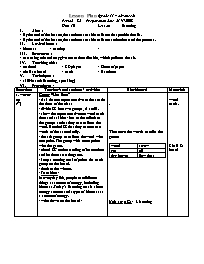Bài soạn môn học Tiếng Anh 11 - Period 82 - Unit 10: Lesson: listening

I. Aims :
- By the end of the lesson, the students are able to listen for specific details.
- By the end of the lesson, the students are able to listen and understand the process.
II. Lexical items :
- biomass - used up -
III. Structures :
- cars using ethanol may give out carbon dioxide, which pollutes the air.
IV. Teaching aids:
- textbook - CD player - Sheet of paper
- chalk an board - cards - Handouts
V. Techniques :
- skill-based ( listening, speaking)
VI. Procedures :
Bạn đang xem tài liệu "Bài soạn môn học Tiếng Anh 11 - Period 82 - Unit 10: Lesson: listening", để tải tài liệu gốc về máy bạn click vào nút DOWNLOAD ở trên
Lesson Plan (grade 11 – advanced) Period : 82 Preparation date :27 /1/2008 Unit 10: Lesson : listening Aims : - By the end of the lesson, the students are able to listen for specific details. - By the end of the lesson, the students are able to listen and understand the process. Lexical items : - biomass - used up - Structures : - cars using ethanol may give out carbon dioxide, which pollutes the air. Teaching aids: - textbook - CD player - Sheet of paper - chalk an board - cards - Handouts Techniques : - skill-based ( listening, speaking) Procedures : State/time Teacher’s and students’ activities Blackboard Materials 1. warm-up (7’) Game: “Hot Seat” - Ask for one representative to the seat in the front of the class - divide SS into two groups, A and B. - show the representative one word each time and ask him / her to describe it to the groups so that they can call out the word. Remind SS that they cannot use words of the same family. - the 1th group to call out the word wins one point. The group with more points wins the game. - check SS’ understanding of instructions and let them start the game. - keep a running total of points for each group on the board. - declare the winner. - Transition: In everyday life, people use different things as sources of energy, including biomass. Today’s listening text is about energy sources and a type of biomass as a source of energy. - write down on the board : . These are the words used in the game: wood straw gas oil dry leaves Saw dust Unit 10: p 82 : Listening -word cards. Chalk & board 2. Pre- listening (7’) Eliciting ideas ( Task a, p.142) - Arrange SS to work in small groups - Tell them to look at the pictures of some kinds of biomass, and discuss how each kind can be used as a source of energy and if they would like to use it as an energy source. - go around to monitor and encourage SS to participate in the discussion. - call on SS to report about their groups - invite SS to give comments - give comments and feedback. - Chalk and board - textbook 3. while-listening. (20’) Activity 1: listen and check. ( task b, p. 143) - tell SS to listen and check the ideas that are mentioned in the listening. - ask SS to compare answers with a partner - have SS listen again and check with the class. Activity 2: listen and compete the diagram ( task c, p.143) -play the CD and tell SS to listen to the second part of the lecture and try to complete the diagram of the biomass cycle. - Ask SS to compare answers in small groups. - Have SS listen again and check with the class. * Expected answers: 2 - 3 - 4 - 6 - 7 * Expected answers: 1. e 2. c 3. b 4.d 5. a 6. f Textbook and CD player CD player and chalk + bb 4. Post-listening (10’) 5. Homework (1’) Speaking : Discussion - ask SS to work in groups - write down on the board some kinds of energy used for the home: - tell them to talk about the source of energy their family used to use for cooking, heating, and lighting in the house, and what they are currently. - go around to monitor and note down errors for correction later. - call on some SS to report about their partners - give feedback and comments on what SS have. Writing - tell SS to write a short paragraph about the sources of energy their family used in the past, why they switched to a different source, and compare the two sources. Diesel gas electricity Fire wood biogas other Expected answers: 1. dispute 2. rained out 3. suspensions 4. walkout 5. boost 6. sold out. Chalk and board
Tài liệu đính kèm:
 p82.doc
p82.doc





